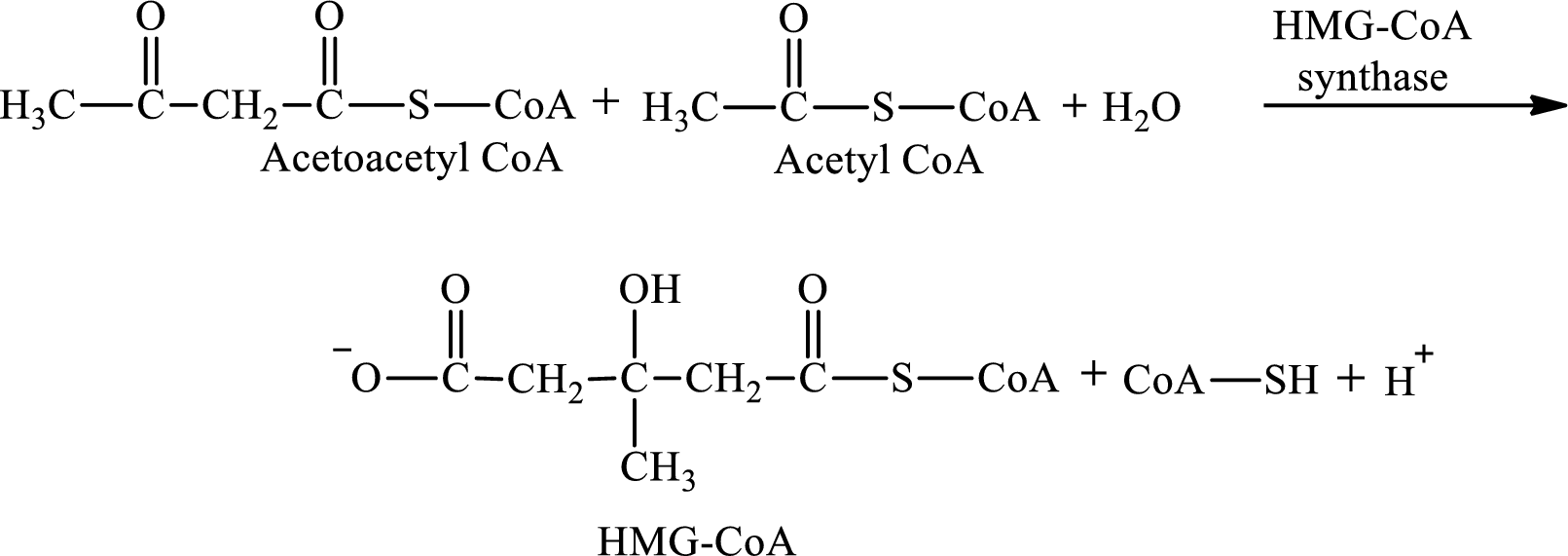
Concept explainers
(a)
Interpretation:
HMG-CoA is encountered in the process (1) glycerol
Concept introduction:
Lipogenesis is the process employed for the synthesis of fatty acid. The starting precursor for the synthesis is acetyl CoA. The enzyme employed for the process is fatty acid synthase. It is a multienzyme complex that ties the reaction responsible for the synthesis of fatty acid. The fatty acid is synthesized in two parts. In the first part, there is citrate-malate shuttle system and in the second part, there is a cyclic process to synthesize saturated fatty acid.
The fatty acids are broken down to provide energy. The breakdown of fatty acids is a three parts process. In the first part, the fatty acid is activated. In the second part, the transportation of fatty acid into the mitochondrial matrix is facilitated by a shuttle mechanism. In the third part, the fatty acid is readily oxidized, cycling through a series of four reactions. In these series of reactions, acyl CoA is degraded to acetyl CoA. This pathway is termed as β-oxidation pathway.
Ketogenesis is a metabolic process by which
Triacylglycerol mobilization is an ongoing process in which triacylglycerols that are stored in the adipose tissue are hydrolyzed. Fatty acids and glycerol are the products of triacylglycerol mobilization. The products are released into the bloodstream.
After entering the bloodstream, the glycerol travels to the kidneys or liver. The first stage of glycerol metabolism occurs in the liver or kidney where it is converted to
(a)
Answer to Problem 25.104EP
HMG-CoA is encountered in ketogenesis.
Explanation of Solution
HMG-CoA is produced in step 2 in ketogenesis.
Step 2 is a condensation reaction. In step 2, acetoacetyl CoA reacts with acetyl CoA and water to produce 3-hydroxyl-3-methylglutaryl (HMG-CoA) and CoA-SH. The reaction for step 2 is:

(b)
Interpretation:
NADPH is encountered in the process (1) glycerol metabolism to dihydroxyacetone phosphate, (2) β-oxidation pathway, (3) ketogenesis, and (4) lipogenesis has to be identified.
Concept introduction:
Lipogenesis is the process employed for the synthesis of fatty acid. The starting precursor for the synthesis is acetyl CoA. The enzyme employed for the process is fatty acid synthase. It is a multienzyme complex that ties the reaction responsible for the synthesis of fatty acid. The fatty acid is synthesized in two parts. In the first part, there is citrate-malate shuttle system and in the second part, there is a cyclic process to synthesize saturated fatty acid.
The fatty acids are broken down to provide energy. The breakdown of fatty acids is a three parts process. In the first part, the fatty acid is activated. In the second part, the transportation of fatty acid into the mitochondrial matrix is facilitated by a shuttle mechanism. In the third part, the fatty acid is readily oxidized, cycling through a series of four reactions. In these series of reactions, acyl CoA is degraded to acetyl CoA. This pathway is termed as β-oxidation pathway.
Ketogenesis is a metabolic process by which ketone bodies are produced by the breakdown of fatty acids and ketogenic amino acids. This metabolic process supplies our organs with needed energy under certain circumstances such as starvation. Fatty acid molecules degrade into acetyl CoA which are utilized as reactants in the process of ketogenesis. These molecules of acetyl CoA undergo the process of condensation twice, followed by chain cleavage and hydrogenation to produce ketone bodies.
Triacylglycerol mobilization is an ongoing process in which triacylglycerols that are stored in the adipose tissue are hydrolyzed. Fatty acids and glycerol are the products of triacylglycerol mobilization. The products are released into the bloodstream.
After entering the bloodstream, the glycerol travels to the kidneys or liver. The first stage of glycerol metabolism occurs in the liver or kidney where it is converted to
(b)
Answer to Problem 25.104EP
NADPH is encountered in lipogenesis.
Explanation of Solution
NADPH acts as the reducing agent in step 2 and 4 of the cyclic process of lipogenesis. NADPH gets oxidized to form NADP+.
Step 2 involves the hydrogenation of acetoacetyl ACP to synthesis β-hydroxybutyrylwith the help of reducing agent NADPH. The reaction of this step is:

Step 4 again involves hydrogenation reaction. In this step, crotonyl ACP is converted to butyryl ACP with the help of reducing agent NADPH. The reaction of this step is:

(c)
Interpretation:
Malonyl ACP is encountered in the process (1) glycerol metabolism to dihydroxyacetone phosphate, (2) β-oxidation pathway, (3) ketogenesis, and (4) lipogenesis has to be identified.
Concept introduction:
Lipogenesis is the process employed for the synthesis of fatty acid. The starting precursor for the synthesis is acetyl CoA. The enzyme employed for the process is fatty acid synthase. It is a multienzyme complex that ties the reaction responsible for the synthesis of fatty acid. The fatty acid is synthesized in two parts. In the first part, there is citrate-malate shuttle system and in the second part, there is a cyclic process to synthesize saturated fatty acid.
The fatty acids are broken down to provide energy. The breakdown of fatty acids is a three parts process. In the first part, the fatty acid is activated. In the second part, the transportation of fatty acid into the mitochondrial matrix is facilitated by a shuttle mechanism. In the third part, the fatty acid is readily oxidized, cycling through a series of four reactions. In these series of reactions, acyl CoA is degraded to acetyl CoA. This pathway is termed as β-oxidation pathway.
Ketogenesis is a metabolic process by which ketone bodies are produced by the breakdown of fatty acids and ketogenic amino acids. This metabolic process supplies our organs with needed energy under certain circumstances such as starvation. Fatty acid molecules degrade into acetyl CoA which are utilized as reactants in the process of ketogenesis. These molecules of acetyl CoA undergo the process of condensation twice, followed by chain cleavage and hydrogenation to produce ketone bodies.
Triacylglycerol mobilization is an ongoing process in which triacylglycerols that are stored in the adipose tissue are hydrolyzed. Fatty acids and glycerol are the products of triacylglycerol mobilization. The products are released into the bloodstream.
After entering the bloodstream, the glycerol travels to the kidneys or liver. The first stage of glycerol metabolism occurs in the liver or kidney where it is converted to
(c)
Answer to Problem 25.104EP
Malonyl ACP is encountered in lipogenesis.
Explanation of Solution
Malonyl ACP is the reactant in step 1 in the cyclic process in lipogenesis.
The first step involves the condensation reaction between acetyl ACP and malonyl ACP. The product formed in the first reaction is acetoacetyl ACP. The reaction of step 1 is:

(d)
Interpretation:
Acetoacetyl CoA is encountered in the process (1) glycerol metabolism to dihydroxyacetone phosphate, (2) β-oxidation pathway, (3) ketogenesis, and (4) lipogenesis has to be identified.
Concept introduction:
Lipogenesis is the process employed for the synthesis of fatty acid. The starting precursor for the synthesis is acetyl CoA. The enzyme employed for the process is fatty acid synthase. It is a multienzyme complex that ties the reaction responsible for the synthesis of fatty acid. The fatty acid is synthesized in two parts. In the first part, there is citrate-malate shuttle system and in the second part, there is a cyclic process to synthesize saturated fatty acid.
The fatty acids are broken down to provide energy. The breakdown of fatty acids is a three parts process. In the first part, the fatty acid is activated. In the second part, the transportation of fatty acid into the mitochondrial matrix is facilitated by a shuttle mechanism. In the third part, the fatty acid is readily oxidized, cycling through a series of four reactions. In these series of reactions, acyl CoA is degraded to acetyl CoA. This pathway is termed as β-oxidation pathway.
Ketogenesis is a metabolic process by which ketone bodies are produced by the breakdown of fatty acids and ketogenic amino acids. This metabolic process supplies our organs with needed energy under certain circumstances such as starvation. Fatty acid molecules degrade into acetyl CoA which are utilized as reactants in the process of ketogenesis. These molecules of acetyl CoA undergo the process of condensation twice, followed by chain cleavage and hydrogenation to produce ketone bodies.
Triacylglycerol mobilization is an ongoing process in which triacylglycerols that are stored in the adipose tissue are hydrolyzed. Fatty acids and glycerol are the products of triacylglycerol mobilization. The products are released into the bloodstream.
After entering the bloodstream, the glycerol travels to the kidneys or liver. The first stage of glycerol metabolism occurs in the liver or kidney where it is converted to
(d)
Answer to Problem 25.104EP
Acetoacetyl CoA is encountered in ketogenesis.
Explanation of Solution
Step 2 is a condensation reaction. In step 2, acetoacetyl CoA reacts with acetyl CoA and water to produce 3-hydroxyl-3-methylglutaryl (HMG-CoA) and CoA-SH. The reaction for step 2 is:

Want to see more full solutions like this?
Chapter 25 Solutions
General, Organic, And Biological Chemistry, Hybrid (with Owlv2 Quick Prep For General Chemistry Printed Access Card)
- A patient who has been drinking large amounts of alcohol for long periods of time shows thefollowing symptoms: apathy, loss of memory, and a rhythmical to-and-fro motion of the eyeballs.Which of the following reactions are most likely to be affected in the patient? A. Conversation of pyruvate to acetyl-CoA B. Conversation of a-ketoglutarate to succinyl-CoA C. Both A and B D. Neither A nor Barrow_forwardWhich of the following statements about the transport of citrate for fatty acid synthesis are false? 1. Citrate is able to cross the inner mitochondrial membrane through the citrate transporter integral membrane protein. II. In the cytoplasm citrate synthase catalyzes the production of acetyl- CoA and oxaloacetate III. After lysis of citrate the oxaloacetate is oxidized to malate by a cytoplasmic form of malate dehydrogenase. II and III only Fonly II only Ill only I and II onlyarrow_forwardWhich of the following statements is/are TRUE about fatty acid activation before β-oxidation? I. The process consumes energy equivalent to two moles of ATP. II. The fatty acid is activated by ATP to give a fatty acyl-CoA.arrow_forward
- If (1-1C)-glucose is metabolized to acetyl-CoA and CO2 via glycolysis and the pyruvate dehydrogenase complex, which are properly labeled products? 1. CH3-1Co-S-COA and CO2 2. 1°CH3-CO-S-COA and CO, 3. 1CHy.Co-S-CoA and CO, 4. CH3-CO-S-COA and 1co: 5. 1CH3-1CO-S-COA and 1co, 0.3 02 04 05arrow_forwardFor each of the steps below, choose (A) if the step pertains to b-oxidation, (B) if the step pertains to fatty acid synthesis, or (C) if the step is common to both processes. ______ Acetyl CoA is produced as a product.______ Activation (the committed step of the process) requires ATP hydrolysis. ______ Accumulated acetyl CoA serves as a substrate.______ The length of fatty acid carbon chain is modified in the mitochondria. ______ ACP acts as the acyl carrier.arrow_forwardCompare and contrast the following items related to lipid metabolism. Cite their main similarities/or differences. 1. Dehydrogenase enzyme vs. dehydratase enzyme(in context of lipid metabolism). 2. Steroid hormones vs. prostaglandins (in terms of their biosynthetic pathways). 3. Fatty acid synthase complex vs. pyruvate dehydrogenase complex.arrow_forward
- Fatty acid biosynthesis begins with the condensation of a two-carbon acetyl residue from acetyl-COA and oxaloacetate, while oxidation leads to the release of two carbon units, acetyl-CoA and fatty acyl-CoA. However, these two processes are not simple reversal. Compare and contrast these two pathways.arrow_forwardIn the mitochondrion is a short-chain carnitineacyltransferase that can take acetyl groups from acetyl-CoA and transfer them to carnitine. How might this be related to lipid biosynthesis?arrow_forwardMatch the coenzymes and/or substrates with their corresponding glycolytic enzymes. Note that an enzyme can match with more than one coenzyme or substrate in the list. ATP NAD+ Dihydroxyacetone phosphate A. Glucose 1-dehydrogenase B. Phosphofructokinase-1 C. Glyceraldehyde 3-phosphate dehydrogenase D. ATPase E. Triose phosphate isomerasearrow_forward
- Consider the following statements: (1) the products of the first two stages of cholesterol biosynthesis are, respectively, mevalonate (C6) and isopentyl pyrophosphate (2) Over 90 percent of the total dietary lipids are triaglycerols (3) The activation stages of fatty acid oxidation involves both CoA & ATP Choices: a. Only one of the statements is true b. All three statements are true c. Two of the three statements are true d. None of the statements are truearrow_forwardMatch the following metabolites with the correct metabolic pathway A. Kreb's cycle v Propionyl-CoA B. Soluble fiber fermenta v Dihydroxy acetone phosphate C. Cholesterol synthesis v succinyl co-A D. glycolysis v Hydroxy methyl glutaryl coA E. Beta oxidation v Hydroxy-butyrate QUESTION 28 When a 23 Carbon fatty acid is metaboližed, what is the total number of (GROSS) ATP produced 7 QUESTION 29 When a 23 Carbon fattv acid is metabolized the numbher of NET ATD produced is? Click Save and Submit to save and submit. Click Save All Answers to save all answers. Esc F3 Fsarrow_forwardThe sources of the three (3) carbons in malonyl-Coa is/are: a. 1 C from C02 and 2 C from acetyl-CoA b. 1 C from HCO3- and 2 C from acetyl-CoA c. 1 C from biotin and 2 C from acetyl-CoA d. All three C from acetyl-CoAarrow_forward
 BiochemistryBiochemistryISBN:9781305577206Author:Reginald H. Garrett, Charles M. GrishamPublisher:Cengage Learning
BiochemistryBiochemistryISBN:9781305577206Author:Reginald H. Garrett, Charles M. GrishamPublisher:Cengage Learning
